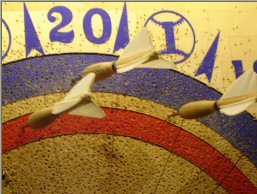Baseball is the “King of all American Dart games”, but it is not the ONLY game you can play on an American style dartboard. I would bet
there are over 100, probably easily.
The first adventure you might want to take on the board that is not “One to Nine” may involve using the common method of calling games.
It’s akin to how a sandwich is assembled at Subway, there are a few decision points, and the end result is a pretty tailored creation.
Decision Points:
- How many innings?
- What are they?
- Are there “qualifiers” for scoring?
- What are they?
- Are we pulling any darts and does anything kill?
- Group or Split Darts?
Other variations include:
- Is it progressive stop?
- Is there a spot?
There may be even more variables that I’m not aware of, but I’ve seen all of these put into play in what you can imagine is a wide variety of games.
I haven’t seen any of these games shot as the main game of a tournament. I have seen them shot throughout the day on side boards at a tournament, and until the lights come on at the end of the night on many occasions.
These are either singles or team games.
Decide on Teams – you can agree on them, splash for them, pick cards or pills, whatever works and is handiest.
The session starts by having one player from each team shoot the cork. There can be as many teams as necessary, and as many players on team as people care to have. But to be honest, two on a team is more popular in my area. It’s more common that I see 3 two-man teams shooting these games rather than 2 three-man teams.
You may as well decide who is going to call the next game before you start. I’ve seen it go in any direction. Lowest scoring team calls the next game, shoot the cork between every game to decide, or even let the winners keep calling – which is a little ballsy because sometimes a winning team can use that advantage to put together a streak of wins.
What are the Components of a Game?
How many innings?
Its as simple as it sounds. Generally they’re three or five inning games.
What are they?
Pick anything you’d like. You can use the whole board, sticking with innings one through nine is boring.
Are there “qualifiers” for scoring?
You can play “all points”, where any point would count. Many, if not most games are “all points”.
But, you can also put obstacles in the way.
Some examples of that may be . . .
“X amount” of Points or Better to Count. If you set the bar at “5 or better to count”, then any inning where a player shoots four or less receives 0 points.
“X amount” of Darts in an Inning. You can set up the game that you need two darts to land in an inning to count. Or 3.
Target before the inning – this is usually done with teams of two, but hey, we are making up games here!
Typically one player shoots the target (which acts as a multiplier), and the other shoots the “inning”.
- If the player misses all three darts at the target, there will be no scoring for the inning.
- If they hits the target once, his partner shoots the inning.
- If player one hits the target twice, their partner shoots the inning and their score for that inning is doubled.
- And yes, if player one hits the target three times, their partner’s score for the inning is tripled.
Popular targets are the triple section of the 13, the circles around the inning numbers, and the cork.
Pulling Darts – is a chance to keep the points that a dart scored, and rethrow it for even more points! Often you’ll pull the reds, and the cork typically counts as being red.
Having the chance to pull darts can also be used as a handicap to even the competition between unequal opponents. One team may be given the power to pull darts, while the other is denied that chance.
Does anything kill? – “Killing” is negating the score for the inning. A game may be designated with “Blues kill”, so if a dart lands in the blue ring, no points can be earned for the inning. I’ve seen “singles kill” and “trips kill” games played as well.
Group or Split Darts – Group darts means all three darts are thrown at the same inning, and then on your next turn you move on to the next inning and throw all three darts at that.
Split darts means you throw one dart at each inning. So, if you’re playing “3 innings, Shendoah 4-6-2 Split Darts”, you would have 3 turns – throwing your first dart at the 4th inning, your second dart at the 6th inning, and your final dart at the 2nd inning on each turn.
Progressive Stop – this is a version of of split darts with a large “kill” area. Any dart that lands outside your target area kills your score for the inning. To ease the difficulty, you can choose to stop shooting at any point in the inning and cash in the points you have acquired.
If you hit points with your first dart, you can “stop”, and rack them up on the scoreboard. Or, you may choose to shoot the next inning. If you miss, your score for the turn is zero. If you hit, yay, your score is higher! You can stop here or try the whole thing again with your third dart.
Is there a spot? – is also as simple as it sounds. If you average a 32, and I average a 22, we may shoot a three inning game, and in the interest of competition, you could give me a “three point spot”. Spots are not the norm, but they are not uncommon either.
I’m sure you can think of plenty of instances where everyone is happy with their teammate, but the teams are not of equal strength. Spots can help even the competition in these situations.










I have a large rectangular Indian Archery and Toy Company dart board. It’s a large baseball diamond mostly green in color on one side and another scene on the other. I am trying to put a date of manufacturing to it. I could attach a photo of it to your return email if you be so kind to reply/
Thank you
Check your email – bob